You are here
- Home
- Energy-Saving Tips
Ways to Save Energy
We understand the importance of conserving natural gas, for your wallet and for the environment. No matter the season, we have provided energy-saving tips for your home or business.
Sealing Your Home

General Leaks
Reducing the amount of air that leaks in and out of your home is the most simple and cost-effective way to cut heating and cooling costs, increase comfort and create a healthier home environment.
Common Leaks Out
- Top Plate
- Duct Register
- Recessed Lights
- Attic Hatch
- Wall Seam
Common Leaks In
- Windows
- Doors
- Vent Fan
- Sill Plate
- Outdoor Faucet
- Dryer Vent
- Air Conditioner
Insulation
Adding insulation in the areas shown here may be the best way to improve your home's energy efficiency. Insulate either the attic floor or under the roof.
Weather Stripping
Sealing gaps around doors and windows can make your home feel warmer — and save you 10-15 percent on your energy bills.
- Seal any air leaks in your home. Air leaks are commonly found around plumbing and wiring, windows and doors, and where the walls meet ceilings. Remember, a quarter-inch gap at the base of a yard-wide exterior door leaks as much air as a three-inch hole in the wall of your home.
- To prevent drafts, weather-strip all doors and windows, or install storm windows and doors. Lack of adequate weather-stripping can cost you $50 or more per year in lost energy.
GENERAL LEAKS

Reducing the amount of air that leaks in and out of your home is the most simple and cost-effective way to cut heating and cooling costs, increase comfort and create a healthier home environment.
Common Leaks Out
- Top Plate
- Duct Register
- Recessed Lights
- Attic Hatch
- Wall Seam
Common Leaks In
- Windows
- Doors
- Vent Fan
- Sill Plate
- Outdoor Faucet
- Dryer Vent
- Air Conditioner
INSULATION

Adding insulation in the areas shown here may be the best way to improve your home's energy efficiency. Insulate either the attic floor or under the roof.
WEATHER STRIPPING

Sealing gaps around doors and windows can make your home feel warmer — and save you 10-15 percent on your energy bills.
Heating and Cooling

Winter
Save energy in the winter by setting your thermostat to 68°F while you're awake, and lowering it while you're asleep or away from home. By turning your thermostat back 10-15° for eight hours, you can save 5-15 percent a year on your heating bill.
Summer
In the summer, follow a similar strategy by setting your thermostat to 78°F when you're at home, and then raising it while you're asleep or away from home.
Programmable Thermostats
Installing a programmable thermostat in your home will help avoid any heating or cooling discomfort by returning your home to a consistent temperature before you wake or return home.
Water Temperature
Water heating is the third-largest energy expense in your home, typically accounting for 13 percent of your utility bill.
Some quick tips:
- Some manufacturers set water heater thermostats at 140°F; most households only need them set at 120°F.
- Insulate your hot water tank and the first six feet of hot and cold pipes to the water heater, but be careful not to cover the thermostat or burner compartment.
- Buy a new energy-efficient water heater, specifically a tankless water heater, reducing both water and energy costs.
- Lower the water-temperature setting of your water heater to 120 degrees for significant savings.
- Wrap the hot water tank with jacket insulation. For safety reasons, wrap only the sides of a gas tank. Wrap the sides and top of an electric tank.
- Do not place furniture over heating and cooling vents. This can block or restrict air flow, making your heating and air conditioning systems work harder.
- Monitor your thermostat setting in the winter. At a setting of 68 degrees, you can see a difference of up to 3 percent in energy costs for every degree you raise or lower the setting.
- Install a setback thermostat. This will lower the temperature while you sleep, and will raise it automatically just before you wake up. It takes far less energy to lower the thermostat and then raise it again than to keep it set at the same setting at all times.
- Regularly maintain your furnace to keep it safe and efficient.
- Run your air conditioner as little as possible to save money and conserve energy.
WINTER

Save energy in the winter by setting your thermostat to 68°F while you're awake, and lowering it while you're asleep or away from home. By turning your thermostat back 10-15° for eight hours, you can save 5-15 percent a year on your heating bill.
SUMMER

In the summer, follow a similar strategy by setting your thermostat to 78°F when you're at home, and then raising it while you're asleep or away from home.
PROGRAMMABLE THERMOSTATS
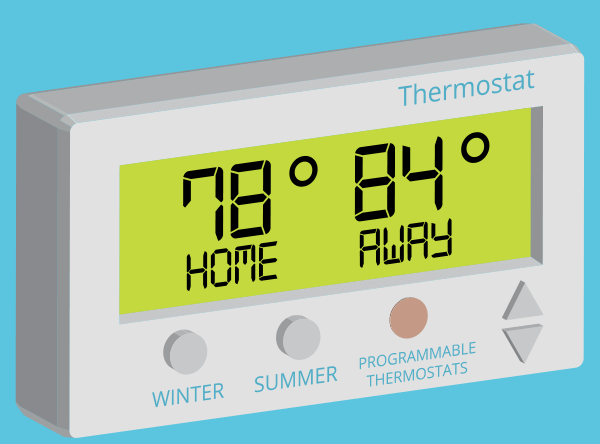
Installing a programmable thermostat in your home will help avoid any heating or cooling discomfort by returning your home to a consistent temperature before you wake or return home.
WATER TEMPERATURE
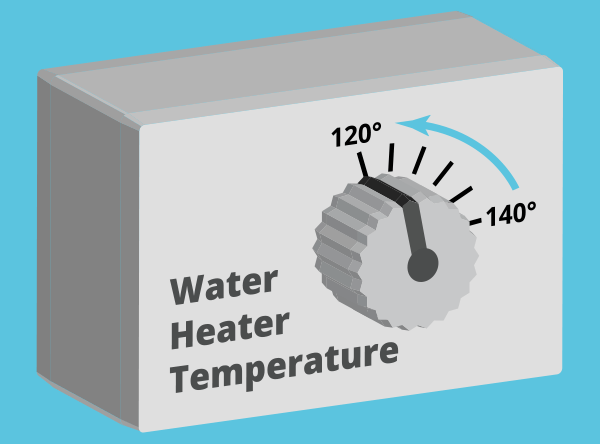
Water heating is the third-largest energy expense in your home, typically accounting for 13 percent of your utility bill.
Some quick tips:
- Some manufacturers set water heater thermostats at 140°F; most households only need them set at 120°F.
- Insulate your hot water tank and the first six feet of hot and cold pipes to the water heater, but be careful not to cover the thermostat or burner compartment.
- Buy a new energy-efficient water heater, specifically a tankless water heater, reducing both water and energy costs.
Appliances and Water Usage

Energy Usage
Saving energy and water can cut household expenditures and benefit the environment. A significant portion of both of these costs comes from your appliances. Energy Star appliances are a great way to start saving energy and water quickly. You can also save by doing laundry and running appliances like dishwashers at off-peak hours. Off-peak hours are typically before 4 p.m. and after 8 p.m. in the summer and from 10 a.m.-5 p.m. and after 8 p.m. in the winter.
Water Usage
A typical U.S. household uses, on average, 260 gallons of water every day, from toilets (27 percent of indoor water usage) to showers (17 percent of indoor water usage) to faucets (16 percent of indoor water usage). Getting low-flow or water-efficient plumbing hardware is a great way to save water and money without sacrificing performance.
- Use the automatic cycle on your clothes dryer. Drying more than needed wastes energy and wears out clothes.
- Check and clean your dryer exhaust vent regularly and remove lint after each load.
- Wash only full loads in washers and dishwashers to minimize hot water use. Your hot water tank is usually the second-greatest energy user in your home.
- Wash clothes in cold water to reduce your energy bill and prevent shrinking and fading.
- Take showers instead of baths. A shower of seven minutes or less under a two-gallon-per-minute, low-flow showerhead is more water-and energy-efficient than taking a bath in a tubful of water.
ENERGY USAGE
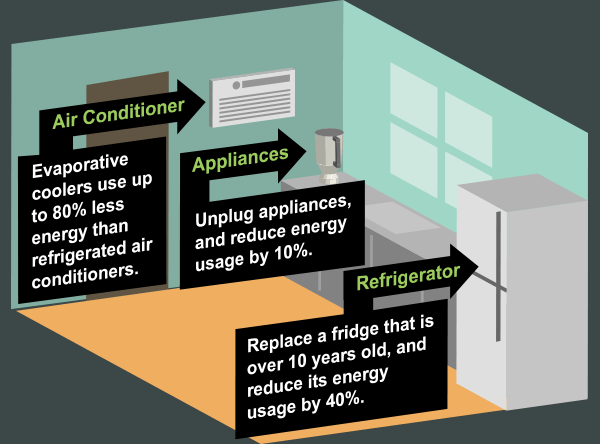
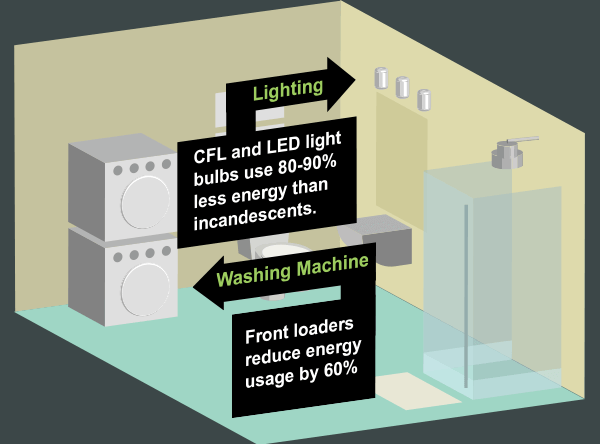
Saving energy and water can cut household expenditures and benefit the environment. A significant portion of both of these costs comes from your appliances. Energy Star appliances are a great way to start saving energy and water quickly. You can also save by doing laundry and running appliances like dishwashers at off-peak hours. Off-peak hours are typically before 4 p.m. and after 8 p.m. in the summer and from 10 a.m.-5 p.m. and after 8 p.m. in the winter.
WATER USAGE
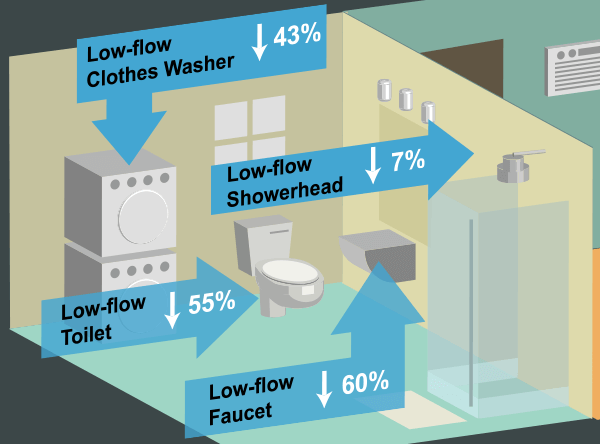
A typical U.S. household uses, on average, 260 gallons of water every day, from toilets (27 percent of indoor water usage) to showers (17 percent of indoor water usage) to faucets (16 percent of indoor water usage). Getting low-flow or water-efficient plumbing hardware is a great way to save water and money without sacrificing performance.
